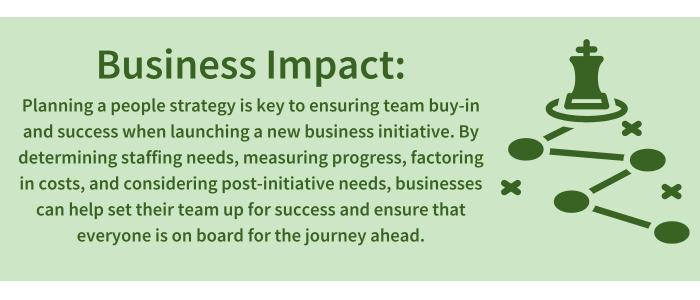Planning a People Strategy for New Initiatives

As a business owner, you may have a grand vision for a new initiative that will take your company to the next level. However, getting your employees on board can be a challenge. It’s easy to assume that your team will simply fall in line and work harder to make your vision come true. But the reality is that they may not see the initiative in the same light as you do. All they see is more work, and that can lead to resistance, frustration, and burnout.
So how can you ensure that your team is fully invested in your new initiative? One key step is to plan a people strategy that takes into account the needs and concerns of your employees. By doing so, you can create a sense of shared ownership and purpose around the initiative, which can help drive engagement and productivity. Let’s take a closer look at why planning a people strategy is so important for small and medium businesses and what kind of questions you need to be asking when you make your plan.
Assess Your Resource Needs
First and foremost, when creating a people strategy, you need to determine what resources you need. Depending on the size and scope of your project, you may need to hire new team members with specific skills and experience. By being intentional about your staffing needs, you can avoid overburdening your existing employees and ensure that everyone has the resources they need to succeed.
• How much work will be needed to accomplish this initiative?
• What can my existing employees contribute?
– How much extra capacity do they have?
– Do they have the skills required for this initiative?
• What can be efficiently outsourced?
• How many new hires will be needed?
Accountability and Contingencies
Another important aspect of a people strategy is accountability. When launching a new initiative, it’s important to have clear goals and metrics in place to measure progress. By involving your team in setting these goals and creating a timeline for achieving them, you can help create a sense of ownership and accountability around the project. Measuring goals and milestones can also let you know if your initiative is in trouble or behind schedule. When possible, it is wise to have contingencies in place if things don’t go according to plan.
• What metrics will help you measure the success of your initiative?
– How will those metrics be tracked?
• What key dates are important to complete your initiative on time?
• What are the things that might go wrong, what’s your backup plan if they do go wrong?
• How are you going to set up expectations and communicate them?
Building a Budget
Of course, any new initiative will come with its own set of costs, and it’s important to factor in your human capital when budgeting for the project. Consider not only the cost of hiring new staff, but also the cost of overtime, benefits, and other expenses associated with your team’s involvement. Being transparent about the budget and staffing needs can also help create a sense of trust and buy-in from your team.
• Have I factored in the cost of human capital management when budgeting for the initiative?
– Are employees going to expect to be rewarded for putting in extra effort to complete this initiative?
– Will there be bonuses related to the initiative?
Go-forward Strategy
Finally, it’s important to think about what will happen to your team members once the initiative is complete. If the project will require ongoing staffing, consider hiring team members with transferable skills who can help maintain the initiative over time. On the other hand, if the project is temporary, be clear with your team members about the duration of their employment and any potential future opportunities.
• How will the completion of the project impact your existing roles, structures and duties?
• Will your employees have the training they need to maintain your initiative if it has ongoing impacts?
• Will temporary staff be told that their position has an end date?
Launching a new initiative can be a daunting task, but planning a people strategy can help make the process smoother and more successful. By taking into account the needs and concerns of your employees, you can create a sense of shared ownership and purpose around the initiative. From determining staffing needs to creating clear goals and celebrating milestones, a people strategy can help set your team up for success. So, before you jump into your next big project, take the time to plan your people strategy and ensure that everyone is on board for the journey ahead.

